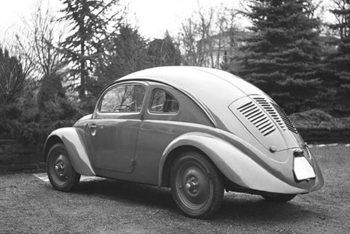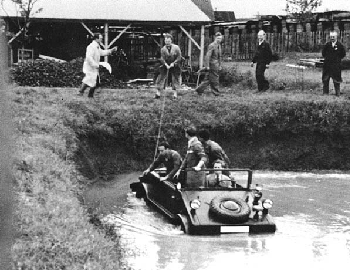VW History 1930's - 1945

Hitlers original design sketch bears little resemblance to the final car
The history of the Beetle goes back to Germany before World War 2, the economy was poor and
most auto manufacturers were building large expensive cars. There was a strong requirement for a cheap
car that was affordable to the average German.
Ferdinand Porsche had previously worked on
some other small cars for Zündapp and NSU that used many elements later to be included in the
Beetle. The Type 32 prototype NSU of 1934 was an air-cooled rear engined four
cylinder horizontally opposed powered car that used torsion bar suspension and
featured beetle-like styling, there were also some other cars that used this innovative
technology around this time as it was considered modern design.
The idea of a car for the people appealed to the young Adolf Hitler who
himself could not drive, but was a car fanatic. Hitler was apparently
influenced by the achievements of Henry Ford and his production lines - reading
Ford's biography while in prison during 1923.
Hitler became chancellor in February 1933 and declared at the Berlin auto show
his intentions to get Germany motoring. Then a year later at the 1934 show he
stated that his government would support the development of a 'peoples car'.
Impressed by Porsche's design capabilities, Hitler delivered him the design
brief of a car that could carry two adults and three children at a speed of
60mph with at least 33 mpg. The price was to be 1000 Reichmarks, not much more
than a motorcycle at the time. Ferdinand Porsche was not convinced that a car
could be made so cheaply, but Hitler was not one to be refused so Porsche accepted the challenge.
Hitler had also by this time sketched his ideas of how the car should look, although the sketch
bears little resemblance to the final car.

W30 Prototype 1937
By late 1935 the first prototypes were on the autobahns, the V1 saloon and a
convertible V2, these cars had aluminium bodies mounted over traditional wooden
frameworks. In 1936 steel bodies mounted over all-steel floorpans were used,
powered by a 984cc, 22bhp engine that could reach a top speed of around 65 mph.
Another 30 prototypes were then made by Daimler-Benz who were not keen to make
such a cheap car as they thought it would damage their high-class reputation.
The development program was then transferred to the Nazi German Labour Front
who would use German workers contributions to pay for a new factory. The
Daimler-Benz built cars were tested at an SS barracks near Stuttgart and driven
in shifts by 200 soldiers, until any minor problems were corrected. During this
time Dr. Porsche visited the US to view some of the production methods used
there, and recruited some German immigrant engineers who had worked in these
factories.
By 1937 tests were under way of the W30 prototype, this car differed slightly in design
by having strengthening lines pressed into the roof - almost certainly to strengthen the body
after using thinner metal in order to cut down costs.
By Mid 1937, Erwin Komenda was working on a new body design - it was decided that the rear slots were to be replaced by a glass window, a problem with the
curved aerodynamic body styling as curved glass was very expensive at this time. So Komenda came up with the idea of two flat windows in the back and the split
window Beetle was born. The rear window meant that the strengthening folds needed to be redesigned, and some other design improvements were also made such as
enlarging the front trunk area. The coachbuilder company Reutter, based in Stuttgart made a full size wooden mockup of the car and the shape of the Beetle that was
to remain mostly unchanged until 1967 was now in place. In early 1938 three versions of this design were quickly built, a sedan, a sunroof model and a convertible - given the
names 801, 802 & 803 because of their registration plates.

Hitler at KDF-Stadt
On the 26 May 1938, Hitler ceremoniously laid the cornerstone of the new
factory, a huge event witnessed by an estimated 70,000 people and 150
reporters, all controlled by the Nazi propaganda machine. It was here that
Hitler declared that the model would be known as the 'KdF-Wagen' or 'Strength
through joy' wagen and the surrounding town that was built to support the
factory would be known as the 'KdF-Stadt'. Hitler also introduced a savings scheme where the public could collect
stamps that would eventually pay for the car.
From May 1938, some more pre-production cars were built and named the VW38 series. The bodies of these cars were still built by the Reutter coachbuilding company at an average of 2 bodies a week.
Click to view photos of the 6th VW38 car, now restored.
Full Production was to start in September
1939 - which unfortunately turned out to be the same month that World War Two was declared.
With the money diverted to the Nazi war effort, none of the thousands who had collected their stamps ever received their
beetle.

Prototype Schwimmwagen
As the War gathered pace, the KdF-Wagen was put on hold and production changed
to military vehicles. The 'Kubelwagen' used the tried and tested and very
successful chassis and air-cooled engine developed for the peoples car. In 1942
the Kubelwagen was joined by the Schwimmwagen - a four wheel drive vehicle
capable of driving on land and in water. By 1943 over 12,000 prisoners of war
were working at the factory, which was by now mostly repairing aircraft.
For most of the war, the KdF plant had managed to escape heavy bombing, the new
town was not on many allied maps. Near the end of the war the factory was used
to manufacture the V1 'buzz bomb'. This bomb was an unmanned aircraft, powered
by an air-breathing pulsejet engine that had the ability to reach Britain from
Germany, and the factory became a main target for the allied bombing raids. It
is estimated that over 3500 V1 bombs hit London before several daylight bombing
raids by the US left the factory in ruins.
View Prototype VW Photo Library
Read what happened after the war
More History